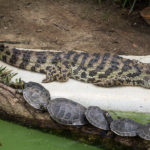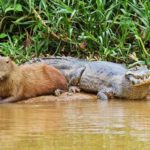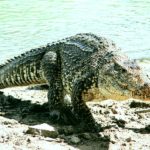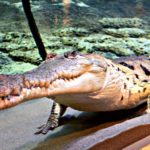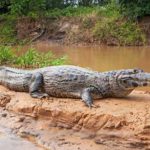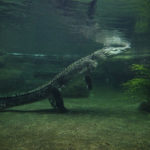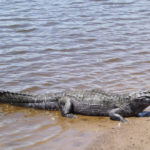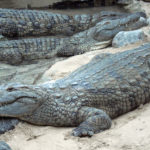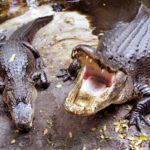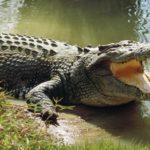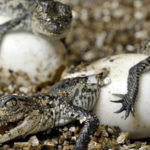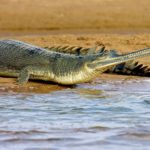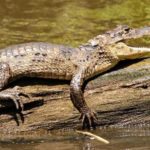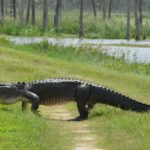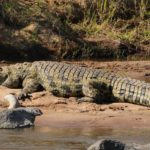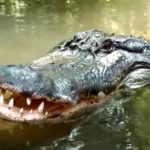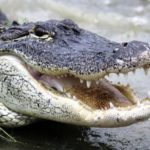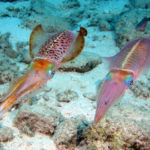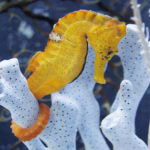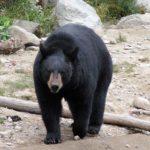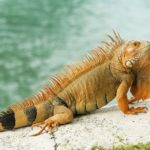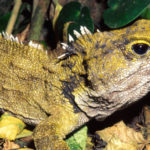Crocodile caiman
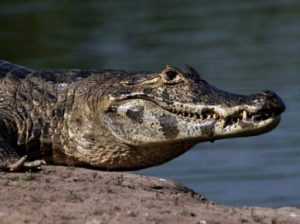 The crocodile caiman differs from other alligators by the presence of a bony abdominal shell. This species of crocodiles feels good in the waters of Central and South America. Adults have a body length of up to two meters. Individual copies reach a length of 2.5 – 2.7 meters.
The crocodile caiman differs from other alligators by the presence of a bony abdominal shell. This species of crocodiles feels good in the waters of Central and South America. Adults have a body length of up to two meters. Individual copies reach a length of 2.5 – 2.7 meters.
Crocodile caimans have the ability to change the color of the body depending on its own temperature. When it decreases, it becomes almost brown.
If we evaluate the appearance of the crocodile caiman, then it can be compared with a representative of the distant Jurassic period, only smaller.
In the strong jaws of this crocodile there are sharp and strong teeth. Their number is not constant, and different caimans can have from 72 to 78 teeth. Caymans can talk. Young, growing crocodile caimans make a croaking sound at danger, older caimans sneak at different situations, but adults give out a loud “barking” sound.
For their carefree life, caimans choose ponds with rich vegetation. They settle in lakes and ponds and feel comfortable when there are islands with floating vegetation in the vicinity. Such islets are good shelter for young Caimans, where they find, at the same time, food for themselves and protection from the attacks of enemies. It is noteworthy that along with the migration of plant islands, caimans make a considerable journey, getting into the open sea. Therefore, they can live in salty water and today you can meet caimans sunbathing on the shore.
The main food for crocodile caimans are crayfish, crabs, fish. Juveniles feed on aquatic insects, mollusks and vegetation of water bodies. Adults often attack animals that they can cope with during a fight, for example, with a small hoofed animal or a baker pig. The cayman has a lightning reaction, he can pretend that he is resting, but in fact he is preparing to make a throw in order to cling to the prey with a dead grip.
Since childhood caymans are distinguished by aggressiveness and anger. These unkind traits are especially evident in the dry season, when caimans lack food. Sometimes in such a hungry situation, aggression becomes excessive and the caimans attack their brethren, becoming cannibals, eating with considerable appetite for a comrade with whom he had just lay beside. It is during this period of hungry aggression that a person must be careful and attentive so as not to become a prey of the Caiman. Although well-fed, he will not touch anyone.
Among the Caimans, there is a social hierarchy in which the weaker and younger animals cannot withstand the assertiveness of the strong, experiencing harassment on their part. Adult caimans, defending their shore, fight among themselves, defending the right to inhabited territory. In this fight, the weakest have to give in and have limited chances for reproduction. Caymans breed throughout the year, but the main breeding time is associated with the rainy season.
Caymans reach sexual maturity in their fifth year of life. After mating, the female caiman on the shore of the reservoir chooses a place close to the water and digs a recess for laying eggs. To increase the survival rate of cubs, the female, often, builds several nests. In one laying there are 15-40 eggs. Depending on the ambient temperature, the incubation period can last from 75 to 90 days. All this time, the female relentlessly protects the nest, not letting anyone close to him. And yet lovers of feast are. The main enemy is lizards, which can kill more than half of all eggs in the nest. Despite the efforts and vigilance of the mother, the hatched little caimans are also the victims of many coastal predators.
At present, the number of Caimans does not cause concern. Their skin with ossified growths is poorly amenable to tanning, so they are not subject to hunting. But lovers of exotic from different countries began to acquire Caimans for home maintenance. Crocodile caiman for this purpose has become a very popular living commodity from all its relatives.
